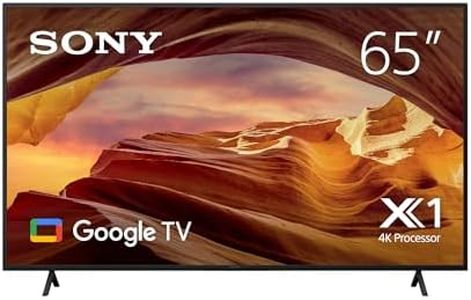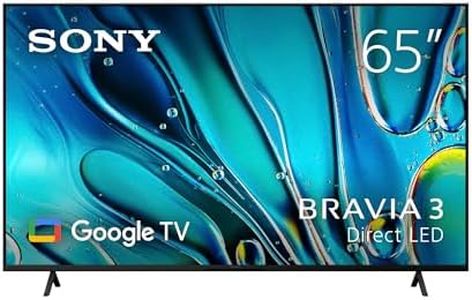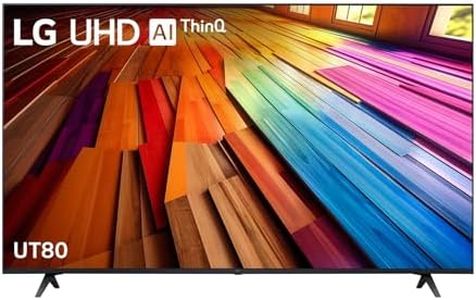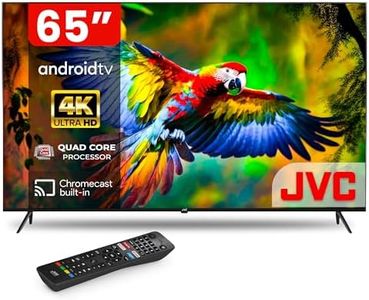We Use CookiesWe use cookies to enhance the security, performance,
functionality and for analytical and promotional activities. By continuing to browse this site you
are agreeing to our privacy policy
10 Best 65 Inch Television
From leading brands and best sellers available on the web.Buying Guide for the Best 65 Inch Television
Selecting a 65-inch television is an exciting process, as this size tends to strike a balance between immersion and fitting well in many living rooms. To find the right TV for you, think about where and how you'll use it most: for movies, sports, gaming, or casual viewing. Also, consider your room size and seating distance to ensure you get the most comfortable and enjoyable experience. Understanding the key specifications will help you narrow down the options that suit your needs best.ResolutionResolution refers to the number of pixels that make up the image on your TV. The most common resolutions for a 65-inch TV are Full HD (1080p) and 4K UHD (2160p), with some high-end models offering 8K. Higher resolution results in sharper and more detailed images, especially noticeable on larger screens. For this size, 4K is generally recommended as it offers a great balance of clarity and affordability. If you mostly watch HD or cable content, 1080p may be sufficient, but if you stream, watch movies, or game in 4K, then 4K resolution is ideal. 8K is still new and not widely supported, but it can be considered for future-proofing.
Panel Type (LED, QLED, OLED, Mini-LED)The panel type determines the way your TV produces light and colors. LED TVs are the most common and offer good picture quality at an affordable price. QLED TVs, which use quantum dots, improve brightness and color range. OLED TVs have organic panels that allow for perfect blacks and excellent contrast because each pixel lights up independently. Mini-LED is a newer technology that offers improved backlighting and higher contrast than standard LED. If you watch TV in bright rooms or value punchy colors, QLED or Mini-LED are strong choices. For home theaters or dark rooms and those who care about deep blacks and contrast, OLED is often preferred.
Refresh RateRefresh rate measures how many times per second the TV refreshes the image, commonly 60Hz or 120Hz. Higher refresh rates provide smoother motion, which is beneficial for sports and fast-paced movies, as well as gaming. For general TV viewing, 60Hz is usually enough. If you frequently watch sports or plan to use your TV for next-generation gaming, a 120Hz panel will give you a smoother, more fluid experience.
HDR SupportHDR (High Dynamic Range) increases the TV's ability to display a broader range of colors and contrasts, making scenes look more vibrant and realistic. There are different formats, such as HDR10, Dolby Vision, and HLG. Basic HDR, like HDR10, is found on most current TVs, while Dolby Vision offers improved picture quality if the content supports it. If you care a lot about lifelike visuals and watch HDR-supported content, look for TVs with good HDR performance and compatibility.
Smart TV FeaturesMost 65-inch TVs today are Smart TVs, meaning they connect to the internet and have built-in apps for streaming services, web browsing, and more. The smart platform varies (like Android TV, Roku, Tizen, or webOS), each with its app selection and user interface. Choosing a TV with a system you're comfortable with, or that supports the services you use most often, will make for a better experience.
Connectivity (HDMI, USB, etc.)Connectivity refers to the types and number of ports available for connecting devices like gaming consoles, soundbars, or streaming sticks. HDMI ports are the most important, and having at least three is ideal for flexibility. Additional USB ports, optical audio out, and Bluetooth are useful for plugging in drives, external speakers, or wireless headphones. Consider your current and potential future devices when deciding how much connectivity you need.
Sound QualitySound quality on many flat-panel TVs is limited by thin speakers. Some TVs have enhanced sound systems, but often, considering the room and your viewing habits will guide whether the built-in audio is enough. If sound is important and you want more cinematic audio, consider a TV with better speakers or plan to pair it with an external soundbar or surround system.
Viewing AnglesViewing angle refers to how well the picture quality holds up when watching the TV from the side rather than the center. Some panel types, such as OLED, generally offer wider viewing angles than most LED or QLED models. If your seating is spread out or off-center, pay attention to this spec to ensure everyone can enjoy a good-quality picture.












